Preparing for Floods
Flood safety tips
Be sure to follow these important flood safety rules to reduce personal risk during a flood:
- Don’t drive through a flooded area. More people drown in cars than anywhere else. The water depth and road condition are always unknown. Vehicles can be swept away in only 12 inches of water.
- Don’t walk through flood waters. Flood currents are also deceptive. Adults can be swept off their feet in only 6 inches of water.
- Avoid electrical lines and equipment. Electrocution is the second leading cause of death during floods. Turn off power at your service panel. Electrical current will travel through flood water.
- Be alert to gas leaks. Turn off gas to your house before a flood. If you smell gas, report it to your gas company and avoid open flames.
- Don’t use gas engines or fires indoors during power outages. These pose risk of carbon monoxide poisoning and house fires.
- Clean anything that has been wet. Flood water will be contaminated with sewage, oil, gasoline, and a variety of chemicals that pose severe health risks.
- Always cooperate with emergency officials and rescue personnel. You can replace personal belongings, but you can't replace someone's life.
Visit floodsmart.gov for more information. Alarms.org also has a flood survival guide available online.
Tips for reducing future damage to your property. The following measures may reduce damage to flood-susceptible properties:
- Grade your yard for proper drainage.
- Seal and protect water entry points. Use watertight seals and flood-resistant building materials.
- Elevate or anchor LP tanks and outbuildings.
- Install a floor drain plug or sewer backup valve to prevent backup flooding. Elevate utilities such as heating and air conditioning systems, water heaters, washers/dryers, and other major appliances to higher floors or on raised platforms.
- Temporarily move furniture, electronics, and other valuables to higher floors; sandbag exterior openings. Mark your fuse or breaker box to quickly identify circuits to floodable areas. Turning off the power to the basement and low areas can reduce damage and save lives.
- Carry and maintain flood insurance.
- To avoid repetitive losses, consider elevating or relocating substantially damaged structures. Assistance may be available through the National Flood Insurance Program's (NFIP) Increased Cost of Compliance (ICC) program.
Flood Insurance
Flooding in Missoula County typically happens every few years in mid- to late spring. Consider purchasing flood insurance well before the river starts to rise! You can purchase flood coverage at any time, but there is typically a 30-day waiting period after you’ve applied and paid the premium before the policy becomes effective, with the following exceptions:
- If the initial purchase of flood insurance is connected to making, increasing, extending or renewing a loan, there is no waiting period. The coverage becomes effective at the time of the loan, provided application and payment of premium is made at or prior to loan closing.
- If the initial purchase of flood insurance is made during the 13-month period following the effective date of a revised flood map for a community, there is a one-day waiting period.
The policy does not cover a "loss in progress," defined by the NFIP as a loss occurring as of 12:01 a.m. on the first day of the policy term. In addition, you cannot increase the amount of insurance coverage you have during a loss in progress.
NFIP flood insurance is sold through private insurance companies and agents, and is backed by the federal government. Check with your insurance provider to see if they have received FEMA flood insurance certification training.

River Levels
If you live in a flood-prone area, stay informed of river levels, forecasts and flood warnings. Visit the National Weather Service Advanced Hydrologic Prediction Service website for the latest river gauge and flooding probability information for:
